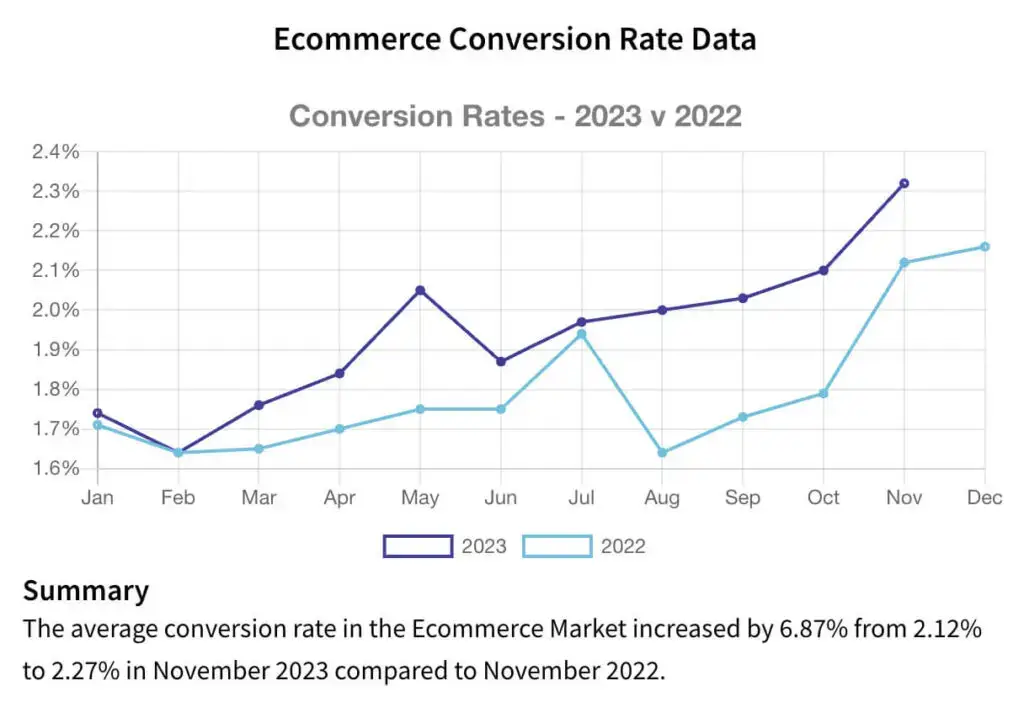The purchase phase in the customer journey is the moment of truth for customer conversion and generally comes directly after the consideration phase. This stage represents the final leap from interest to commitment, where every obstacle could mean a lost sale. Globally, the average e-commerce conversion rate hovers between 2-3%, with certain sectors like food and beauty seeing rates slightly higher. Yet, most sites face an average 70% cart abandonment rate, underscoring the need for seamless, optimized purchase pathways.
Effective purchase-phase strategies can be game-changers. Digital catalogs play a crucial role, offering multiple conversion points—such as WhatsApp inquiries, email orders, wishlists, and embedded cart functions—making it easy for customers to buy in the way that best suits them. Businesses can overcome common friction points and increase conversions by creating an experience that flows smoothly from product selection to checkout.

Source: Smart Insights
The Role of Digital Catalogs in Customer Conversion
Digital catalogs can enhance customer conversion by providing multiple touchpoints, allowing customers to complete purchases easily. Here’s how digital catalogs contribute to a smooth purchase experience:
- Add-to-Cart & Checkout: Simplify the purchase journey by enabling direct checkout within the catalog.
- Multiple Conversion Options: Enable customers to complete purchases or ask questions via WhatsApp, email, or on-site options for a more personalized experience.
- Wishlists: Allow customers to save products for future consideration, increasing chances of purchase when they return.
- Website Embedding: Integrate the catalog directly into your website for a cohesive shopping experience.
- Inventory & Price Updates: Keep customers informed of real-time stock levels and prices, helping them make informed decisions quickly.
Each conversion point allows customers to interact with your catalog in ways that suit their preferences, improving the likelihood of a completed sale.
eCommerce Integration in a Digital Catalog
Boosting Customer Conversion by Reducing Abandon Cart Rates
One of the primary challenges in the purchase phase is cart abandonment, and this requires targeted strategies to ensure more customers complete their purchases:
- Automated Reminders: Sending reminders via WhatsApp or email to notify customers about items left in their cart can help bring them back.
- Discount Offers: Offering time-sensitive discounts or incentives when a cart is abandoned can increase conversions.
- Streamlined Checkout Process: A lengthy or complex checkout can deter customers. Simplify the process by reducing the number of steps and offering guest checkout.
- Mobile Optimization: As more shoppers use mobile devices, ensuring the mobile-friendly checkout process can prevent frustration and keep customers engaged.
These tactics serve to create a fluid purchase experience, directly addressing common causes of cart abandonment and improving customer conversion.

Source: Baymard
Post-Purchase Retention: Turning Purchasers into Loyal Customers
The customer journey doesn’t end at the purchase phase; investing in post-purchase engagement strategies is equally critical to driving customer retention and long-term loyalty. Retaining customers is more cost-effective than acquiring new ones and is crucial to fostering advocacy.
- Personalized Follow-ups: Send thank-you emails, follow-up messages, or order updates to make customers feel valued.
- Post-Purchase Support: Ensure customers can access support and resources for any post-purchase inquiries.
- Exclusive Offers & Loyalty Programs: Reward repeat customers with loyalty points, discounts, or early access to new collections to increase their lifetime value.
Retention strategies create positive post-purchase experiences, which keep customers coming back for future purchases and prevent churn. A personalized approach to customer support and consistent follow-up can leave a lasting impression, encouraging customers to continue engaging with your brand.
Advocacy: Turning Loyal Customers into Brand Advocates
Loyal customers who are delighted with their experience are likelier to become brand advocates, promoting your business to friends and family. Digital catalogs can also help at this stage by making it easy for satisfied customers to share products they love.
- Encourage Reviews: Invite customers to leave reviews on your website or social media channels.
- Social Sharing Features in Catalogs: Include shareable links within digital catalogs to allow customers to share favorite products easily.
- Referral Programs: Create referral incentives to encourage customers to bring in new shoppers.
Advocacy reinforces customer loyalty and draws new leads into the purchase funnel through trusted recommendations. Satisfied customers will naturally advocate for brands that provide excellent, memorable experiences, helping expand your reach organically.

Source: Enchant
Building Lasting Customer Relationships Throughout The Purchase Journey
Businesses can transform one-time shoppers into loyal customers and brand advocates by optimizing the purchase journey and nurturing post-purchase engagement. Digital catalogs, when designed to accommodate the full customer journey, not only increase customer conversion but also build lasting relationships that elevate your brand’s reputation.


